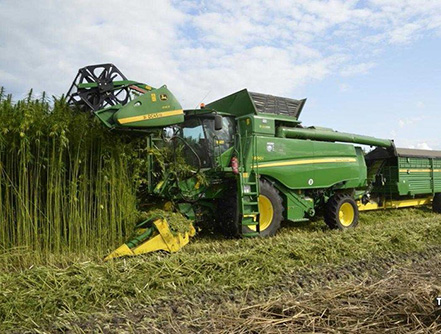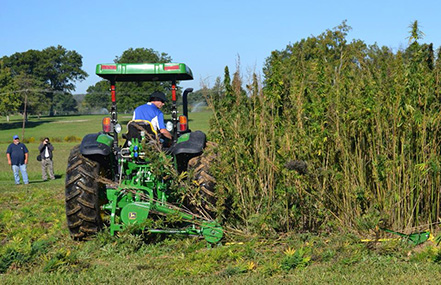New
Industrial hemp (Cannabis sativa L.) production practices are gradually being adapted for U.S. conditions, but harvest timing and methods remain some of the most critical and least standardized aspects of hemp production in Missouri. This factsheet compiles general recommendations based on agronomic studies and best practices from other hemp-producing states with similar agro-climatic conditions.
Grain (seed) hemp
Harvest timing
- Typical period is from mid-September to early October, depending on planting date and variety.
- Maturity indicators:
- Seed color changes from green to brown
- Bracts dry and begin to open
- 70–80% of seeds are mature and firm to the touch
- Maturity is affected by the variety. Some varieties don’t mature early enough to produce seeds in Missouri.
- Delaying harvest increases the risks of shattering, mold, and bird damage.
- Drying the seed is required to maximize yields.

Harvest methods
- Equipment: Standard combine harvester with modifications
- Reduce rotor speed to avoid seed damage
- Use air-screen cleaning systems to manage chaff/residue.
- Post-harvest:
- Dry seeds to below 10% moisture content
- Clean seeds to remove bracts and debris
- Challenges: Hemp fiber can wrap around moving parts. Frequent cleaning is required during harvest.

Fiber hemp
Harvest timing
- Typical period: Late August to early September, ~70–100 days after planting.
- Harvest stage: Harvested once the plants have reached full height and the lower leaves start to turn yellow. This ensures that the harvested fibers are durable and of high quality.
- Delaying harvest increases lignin content, reduces fiber quality and processing ease.
Harvest methods
- Equipment: Sickle bar mower or disc mower
- Cut plants 2–4 inches above ground
- Lay plants in windrows for field retting (Retting is a natural decomposition of pectin that binds fibers and is essential for fiber quality).
- The retting process takes about 2–4 weeks, depending on plant moisture.
- Turn windrows 1–2 times for uniform retting and dry to a moisture content of <15%.
- Bale with a round or large square baler for transport
Cannabinoid (CBD) hemp
Harvest timing
- Typical period: September to mid-October
- Indicators:
- Pistils on flowers turn from white to orangish-brown (70–80%)
- Trichomes become milky or amber colored when viewed under a magnifier
- Lab testing confirms peak CBD and compliant THC levels (<0.3% per USDA rules)
- Late harvest timing can cause THC to rise above legal limits.
Harvest methods
- Manual harvesting is common in small fields or high-CBD varieties
- Workers cut plants at the base with sickles and remove flowers by hand
- Mechanical harvesting: Modified nursery or tobacco harvesters used in large-scale operations
- Drying:
- Hang-dry plants in barns/sheds or use forced-air dryers
- Dry to 10–12% moisture within 48 hours to prevent mold
- CBD production is highly labor-intensive. Harvesting and drying are major bottlenecks.
References
- Bamka, W., & Komar, S., (2019). Introduction to Industrial Hemp - Basic Production Agronomy. Rutgers University Cooperative Extension
- Cornell Hemp Resources
- Dhakal, M., Lapham, C., Ghale, Arash., & Amith, A., (2023). Growing Industrial Hemp as an Organic Cash Crop.
- Fike, J. (2016). Industrial Hemp: Renewed Opportunities for an Ancient Crop. Critical Reviews in Plant Sciences, 35(5–6), 406–424.
- Floraflex® Newsletter (2023). Hemp Harvesting Techniques: Timing, Equipment, and Methods.
- Penn State (2022). Industrial Hemp Production
- Purdue University
- Sott, H.R., Louis, M. M., Skousen, J., (2018). Industrial Hemp Planting and Production. West Verginia University Extension Service
- Williams, D., Mundell, R., (2018). An Introduction to Industrial Hemp and Hemp Agronomy. University of Kentucky Cooperative Extension Service